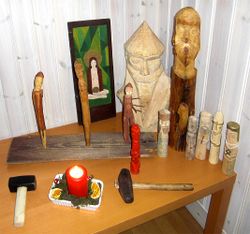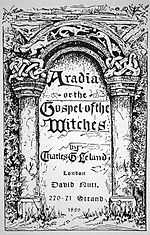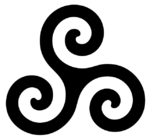Portal:Wicca/Selected article
Usage
The layout design for these subpages is at Portal:Wicca/Selected article/Layout.
- Add a new Featured article to the next available subpage.
- Update "max=" to new total for its {{Random portal component}} on the main page.
Selected articles
{{../box-header|Wicca/Selected article 1 | Portal:Wicca/Selected article/1 }} Portal:Wicca/Selected article/1
The Horned God is one of the two primary deities found in some European pagan religions. He is often given various names and epithets, and represents the male part of the religion's duotheistic theological system, the other part being the female Triple Goddess. In common Wiccan belief, he is associated with nature, wilderness, sexuality, hunting and the life cycle. Whilst depictions of the deity vary, he is always shown with either horns or antlers upon his head, often depicted as being theriocephalic, in this way emphasizing "the union of the divine and the animal", the latter of which includes humanity.
The term Horned God itself predates Wicca, and is an early 20th century syncretic term for a horned or antlered anthropomorphic god with pseudohistorical origins who, according to Margaret Murray's 1921 The Witch-Cult in Western Europe, was the deity worshipped by a pan-European witchcraft-based cult, and was demonized into the form of the Devil by the Mediaeval Church.
{{../box-footer|}} {{../box-header|Wicca/Selected article 2 | Portal:Wicca/Selected article/2 }} Portal:Wicca/Selected article/2 The Wiccan Rede is a statement that provides the key moral system in the Neopagan religion of Wicca and other related Witchcraft-based faiths. A common form of the Rede is An it harm none, do what ye will.
The Rede in its best known form as the "eight words" couplet was first publicly recorded in a speech by Doreen Valiente in 1964. A similar phrase, Do what thou wilt shall be the whole of the Law, appears in Aleister Crowley's works by 1904, in The Book of the Law (though as used by Crowley it is half of a statement and response, the response being "Love is the law, love under will"). According to B.A. Robinson of the Ontario Consultants on Religious Tolerance, Crowley adopted this line from François Rabelais, who in 1534 wrote, "DO AS THOU WILT because men that are free, of gentle birth, well bred and at home in civilized company possess a natural instinct that inclines them to virtue and saves them from vice. This instinct they name their honor".
{{../box-footer|}} {{../box-header|Wicca/Selected article 3 | Portal:Wicca/Selected article/3 }} Portal:Wicca/Selected article/3
Germanic neopaganism (also known as heathenism,[1][2]
heathenry,[3][4] or Germanic heathenry[5][6]) is the contemporary revival of historical Germanic paganism. Precursor movements appeared in the early 20th century in Germany and Austria. A second wave of revival began in the early 1970s. Since its first times heathenism has developed according to diverse denominations, the most prominent ones amongst all being Ásatrú, Odinism, Forn Siðr and Theodism.[1] Attitude and focus of adherents may vary considerably, from strictly historical polytheistic reconstructionism to syncretist (eclectic), pragmatic psychologist, occult or mysticist approaches. Germanic neopagan organizations cover a wide spectrum of belief and ideals. Different terms exist for the various types of Germanic neopaganism. Some terms are specific in reference whereas other are blanket terms for a variety of groups.[7]
{{../box-footer|}} {{../box-header|Wicca/Selected article 4 | Portal:Wicca/Selected article/4 }} Portal:Wicca/Selected article/4 The Panthean Temple, abbreviated as PTC as the Panthean Temple of Connecticut, is located in New Haven County, Connecticut and was the first Pagan and Wiccan church to incorporate in the state of Connecticut under its first name of the "Pagan Community Church,". It was founded by Rev. Alicia Lyon Folberth, in 1995.
The Panthean Temple is open to Witches and Pagans of all traditions who honor harm none, which they consider to be a universal tenet of all true spiritual paths. Their practices are devotional, and are primarily Odyssean tradition, although individual public rituals may vary depending on the people leading them and the traditions they practice, but do not consider themselves eclectic.
Odyssean Wicca has its roots within British Traditional Wicca but like the Wiccan Church of Canada, the temple's purpose is to provide public ministry services, such as open worship, rites of passage, and prison and hospital visitations. The Panthean Temple is notable for its large festival, "Beltaine: A Pagan Odyssey," which began in 1999.
{{../box-footer|}} {{../box-header|Wicca/Selected article 5 | Portal:Wicca/Selected article/5 }} Portal:Wicca/Selected article/5
Aradia, or the Gospel of the Witches is a book composed by the American folklorist Charles Leland that was published in 1899. It contains what he believed was the religious text of a group of pagan witches in Tuscany, Italy that documented their beliefs and rituals, although various historians and folklorists have disputed the existence of such a group. In the 20th century, the book was very influential in the development of the contemporary Pagan religion of Wicca.
Leland's work remained obscure until the 1950s, when other theories about, and claims of, "pagan witchcraft" survivals began to be widely discussed. Aradia began to be examined within the wider context of such claims. Scholars are divided, with some dismissing Leland's assertion regarding the origins of the manuscript, and others arguing for its authenticity as a unique documentation of folk beliefs. Along with increased scholarly attention, Aradia came to play a special role in the history of Gardnerian Wicca and its offshoots, being used as evidence that pagan witchcraft survivals existed in Europe, and because a passage from the book's first chapter was used as a part of the religion's liturgy. After the increase in interest in the text, it became widely available through numerous reprints from a variety of publishers, including a 1999 critical edition with a new translation by Mario and Dina Pazzaglini.
{{../box-footer|}} {{../box-header|Wicca/Selected article 6 | Portal:Wicca/Selected article/6 }} Portal:Wicca/Selected article/6
Celtic Reconstructionist Paganism (also Celtic Reconstructionism or CR) is a polytheistic, animistic, religious and cultural movement. It is an effort to reconstruct and revive, in a modern Celtic cultural context, pre-Christian Celtic religions.
Celtic Reconstructionist Paganism originated in discussions among amateur scholars and Neopagans in the mid 1980s, and evolved into an independent tradition by the early 1990s. Celtic Reconstructionism represents a polytheistic reconstructionist approach to Celtic Neopaganism, emphasising historical accuracy over eclecticism such as is found in many forms of Neo-druidism. Currently, "Celtic Reconstructionist Paganism" (CR) is an umbrella term, with a number of recognized sub-traditions or denominations.
{{../box-footer|}} {{../box-header|Wicca/Selected article 7 | Portal:Wicca/Selected article/7 }} Portal:Wicca/Selected article/7 Stregheria is a form of ethnic Italian form of Wicca originating in the United States, popularized by Raven Grimassi since the 1980s. Stregheria is sometimes referred to as La Vecchia Religione ("the Old Religion"). The word stregheria is an archaic Italian word for "witchcraft", the modern Italian word being stregoneria.
Grimassi taught what he called the Aridian tradition from 1980. He mixed elements of Gardnerian Wicca with ideas inspired by Charles G. Leland's Aradia, or the Gospel of the Witches (1899). The name "Aradia" is due to Leland, who claimed that Erodiade (the Italian name of Herodias) was the object of a " witch-cult" in medieval Tuscany. Since 1998, Grimassi has been advocating what he calls the Arician tradition, described as an "initiate level" variant of the religion, involving an initiation ceremony.
Stregheria has both similarities and differences with Wicca, and in some ways resembles reconstructionist Neopaganism focussed on a specific nation or culture (in this case the folk religion of medieval Italy, allegedly containing traditions derived from Etruscan religion). Stregheria honors a pantheon centered around a Moon Goddess and a Horned God regarded as central, paralleling Wiccan views of divinity.
{{../box-footer|}} {{../box-header|Wicca/Selected article 8 | Portal:Wicca/Selected article/8 }} Portal:Wicca/Selected article/8
Thelema is a religious philosophy (referred to by some as a religion) that was established, defined and developed by the early 20th century British writer and ceremonial magician, Aleister Crowley. He believed himself to be the prophet of a new age, the Æon of Horus, based upon a religious experience that he had in Egypt in 1904. By his account, a possibly non-corporeal being that called itself Aiwass contacted him and dictated a text known as The Book of the Law or Liber AL vel Legis, which outlined the principles of Thelema.
The Thelemic pantheon includes a number of deities, focusing primarily on a trinity of deities adapted from ancient Egyptian religion, who are the three speakers of The Book of the Law: Nuit, Hadit and Ra-Hoor-Khuit. The religion is founded upon the idea that the 20th century marked the beginning of the Aeon of Horus, in which a new ethical code would be followed; "Do what thou wilt shall be the whole of the Law". This statement indicated that adherents, who are known as Thelemites, should seek out and follow their own true path in life, known as their True Will rather than their egoic desires. The philosophy also emphasizes the ritual practice of Magick.
{{../box-footer|}} {{../box-header|Wicca/Selected article 9 | Portal:Wicca/Selected article/9 }} Portal:Wicca/Selected article/9 Kemetism (also Kemeticism; both from km.t, the native name of Ancient Egypt) is a term for Egyptian neopaganism, i.e. neopagan revivals of Ancient Egyptian religion which developed in the United States from the 1970s. Kemetism is considered to be a traditional African religion. There are several main groups, each of which take a different approach to their beliefs, ranging from eclectic to polytheistic reconstructionist.
- Pan-Africanist or black nationalist: The Ausar Auset Society, established by Ra Un Nefer Amen, is among several large US - based groups, that take a syncretic approach to the Ancient Egyptian beliefs and practices. Such groups tend to have a large appeal to those identifying with the African diaspora. The Ancient Egyptian Order (a.k.a. "Nuwaubian Nation of Moors" and other names) was a black supremacist cult led by Malachi York.
- Kemetic Wicca (also Tameran Wicca, from t3 mry "Beloved Land", another native term for "Egypt") is an eclectic approach combining Ancient Egyptian elements with Wicca.
- Kemetic Revivalism and Reconstruction, a reconstructionist, which include academic approaches informed by Egyptology, notably Kemetic Orthodoxy of Tamara L. Siuda and Kerry Wisner's Akhet Hwt Hwr
- Neo-Atenism is a neopagan revival not of Egyptian polytheism, but of the monotheistic faith introduced under Akhenaten in the Amarna period (r. 1353–1336 BC)
{{../box-footer|}} {{../box-header|Wicca/Selected article 10 | Portal:Wicca/Selected article/10 }} Portal:Wicca/Selected article/10 Hellenic Polytheistic Reconstructionism (also Hellenic Reconstructionism) refers to various reconstructionist movements that revive ancient Greek religious practices, emerging since the 1990s. Since 1997 the movement in Greece has been institutionalized under the Supreme Council of Ethnikoi Hellenes. Polytheistic reconstructionism is not a religion itself, but is the methodology for re-establishing a historical polytheistic (or pre-Christian) religion in the modern world.
Hellenismos, or Hellenism, is the Hellenic religion, a traditional polytheistic religion and way of life, revolving around the Greek Gods, primarily focused on the Twelve Olympians, and embracing ancient Hellenic values and virtues.
{{../box-footer|}} {{../box-header|Wicca/Selected article 11 | Portal:Wicca/Selected article/11 }} Portal:Wicca/Selected article/11 Slavic Neopaganism (also known as Slavianstvo (Slavianism)[8] or Rodnovery;[9][10] Russian: Родноверие / Rodnoverye,[11] Родославие / Rodoslavie; Ukrainian: Рiдна Вiра / Ridna Vira, Рідновірство / Ridnovirstvo, Рідновір'я / Ridnoviriya; Serbian: Родноверје / Rodnoverje, Родна вера / Rodna vera), Belarusian: Роднавераваннe / Rоdnaveravanne; Polish: Rodzimowierstwo) is a modern sometimes fakeloric,[12][13][14], and polytheistic, reconstructionistic, and Neopagan religion; its adherents call themselves Rodnovers (Ukrainian: Ridnoviry), and consider themselves to be the legitimate continuation of pre-Christian Slavic religion.[15]
{{../box-footer|}} {{../box-header|Wicca/Selected article 12 | Portal:Wicca/Selected article/12 }} Portal:Wicca/Selected article/12 Portal:Wicca/Selected article/12 {{../box-footer|}} {{../box-header|Wicca/Selected article 13 | Portal:Wicca/Selected article/13 }} Portal:Wicca/Selected article/13 Portal:Wicca/Selected article/13 {{../box-footer|}} {{../box-header|Wicca/Selected article 14 | Portal:Wicca/Selected article/14 }} Portal:Wicca/Selected article/14 Portal:Wicca/Selected article/14 {{../box-footer|}} {{../box-header|Wicca/Selected article 15 | Portal:Wicca/Selected article/15 }} Portal:Wicca/Selected article/15 Portal:Wicca/Selected article/15 {{../box-footer|}} {{../box-header|Wicca/Selected article 16 | Portal:Wicca/Selected article/16 }} Portal:Wicca/Selected article/16 Portal:Wicca/Selected article/16 {{../box-footer|}} {{../box-header|Wicca/Selected article 17 | Portal:Wicca/Selected article/17 }} Portal:Wicca/Selected article/17 Portal:Wicca/Selected article/17 {{../box-footer|}} {{../box-header|Wicca/Selected article 18 | Portal:Wicca/Selected article/18 }} Portal:Wicca/Selected article/18 Portal:Wicca/Selected article/18 {{../box-footer|}} {{../box-header|Wicca/Selected article 19 | Portal:Wicca/Selected article/19 }} Portal:Wicca/Selected article/19 Portal:Wicca/Selected article/19 {{../box-footer|}} {{../box-header|Wicca/Selected article 20 | Portal:Wicca/Selected article/20 }} Portal:Wicca/Selected article/20 Portal:Wicca/Selected article/20 {{../box-footer|}} {{../box-header|Wicca/Selected article 21 | Portal:Wicca/Selected article/21 }} Portal:Wicca/Selected article/21 Portal:Wicca/Selected article/21 {{../box-footer|}} {{../box-header|Wicca/Selected article 22 | Portal:Wicca/Selected article/22 }} Portal:Wicca/Selected article/22 Portal:Wicca/Selected article/22 {{../box-footer|}} {{../box-header|Wicca/Selected article 23 | Portal:Wicca/Selected article/23 }} Portal:Wicca/Selected article/23 Portal:Wicca/Selected article/23 {{../box-footer|}} {{../box-header|Wicca/Selected article 24 | Portal:Wicca/Selected article/24 }} Portal:Wicca/Selected article/24 Portal:Wicca/Selected article/24 {{../box-footer|}} {{../box-header|Wicca/Selected article 25 | Portal:Wicca/Selected article/25 }} Portal:Wicca/Selected article/25 Portal:Wicca/Selected article/25 {{../box-footer|}}
- ↑ 1.0 1.1 T. Sheil & A. Sheil. What is Heathenism?. 2008. Retrieved 3rd August 2011. Quote: "There have been several names coined for various Heathen groups: Hedenskap, Asatru, Odinism, Thorism, Theod, Troth, Urglaawe, etc. Most of these terms relate to specific branches of Heathenism. The term, that covers all of them is Heathenism."
- ↑ Arlie Stephens. Deity and Humanity in Modern Heathenism. Regarding terminology she writes: "Other names for our religion include Asatru, Forn Sed, Norse Paganism, and Heithni. The various names reflect both organizational boundaries and differences of emphasis; I use “Heathenism” in this paper because it’s generally seen as including the broadest range."
- ↑ Heathenry Portal of the BBC Religions Portal. "Heathenry is a reconstruction of pre-Christian North European religion."
- ↑ Editorial Preface of The Journal of Contemporary Heathen Thought, a Germanic Neopagan publication with contributions from the Ásatrú Folk Assembly, the Odinic Rite, and other organised or independent adherents, uses "Heathenism/-ry" as the name of the whole movement.
- ↑ James Hjuka Coulter. Germanic Heathenry: A Practical Guide. 2003. ISBN 1410765857
- ↑ Lauren Bernauer. Modern Germanic Heathenry and the Radical Traditionalists. Retrieved 30th July 2011. Example of academic publication using the label "Germanic Heathenry".
- ↑ Arlea Anschütz and Stormerne Hunt, Call us Heathens!
- ↑ http://images.rca.org/docs/mission/country-profiles/Russia.pdf
- ↑ Kavykin O.I. "Rodnovery". Samoidentifikatsiia neoiazychnikov v sovremennoi Rossii: Monografiia. Moskva IA RAN, 2007. ISBN 9785912980176
- ↑ English form promulgated by the largest Russian organization is Rodnovery.com
- ↑ Хто такі рідновіри?
- ↑ Harle, Peter. Neo-Pagan Sacred Art and Altars: Making Things Whole, Journal of American Folklore - Volume 117, Number 463, Winter 2004, pp. 104-105
- ↑ V.Shnirelman "Неоязычество и национализм", Восточноевропейский ареал // Исследования по прикладной и неотложной этнологии. № 114. ИЭА РАН, 1998 г.; Неоязычество на просторах Евразии. «Библейско-богословский институт св. апостола Андрея», Москва, 2001, pp. 68, 102, 177, 168.
- ↑ M.Vasiliev, Review: Неоязычество на просторах Евразии. М., 2001 // Славяноведение. 2002. № 4. С. 102
- ↑ The 2007 International Conference - Russian Rodnoverie (Aitamurto)



